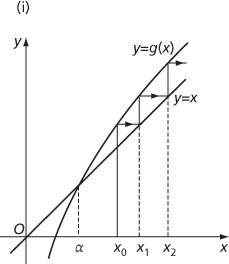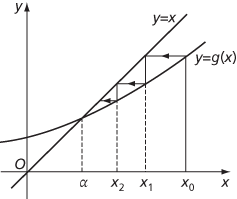To find a root of an equation f(x)=0 by the method of fixed‐point iteration, the equation is first rewritten in the form x = g(x). Starting with an initial approximation x0 to the root, the values x1, x2, x3,…are calculated using xn + 1 = g(xn). The method is said to converge if these values tend to a limit α. If they do, then α = g(α) and so α is a root of the original equation.

Repelling fixed point |g’(α)|>1

Attracting fixed point |g’(α)|<1
A root of x = g(x) occurs where the graph y = g(x) meets the line y = x. It can be shown that, if |g′(α)|<1, then the sequence converges for suitably close initial values x0, and α is called attracting. If |g′(α)|>1, then the sequence diverges from α for nearby initial values x0. This is illustrated in the figures; such diagrams are called ‘cobweb plots’, and the process is called ‘cobwebbing’. The equation x3−x−1=0 has a root α between 1 and 2, so we take x0=1.5. The equation can be written in the form x = g(x) in several ways, such as (i) x = x3−1 or (ii) x = (x + 1)1/3. In case (i), g′(x)=3x2, g′(α) > 3 > 1 and so α is repelling for this iteration; in case (ii), and g′(α)<2−2/3/3<1 and so α is attractive.
More generally a fixed point α ∈ X of a function f:X→X is attracting if the fixed-point iteration converges to α for initial values in a neighbourhood of α and is repelling if there is a neighbourhood of α such that the fixed-point iteration eventually moves out of the neighbourhood for all initial values other than α.
- inertial reference frame
- Inertial Upper-Stage rocket
- inertia matrix
- inertia switch
- inerting agent
- inertinite
- inert-pair effect
- inevitability
- inextensible string
- inf
- infall velocity
- infant industry
- infant mortality
- infaunal
- infeasible
- infection
- inference
- inference engine
- inference to the best explanation
- inferential role semantics
- inferior
- inferior conjunction
- inferior good
- inferior planet
- inferred reserve